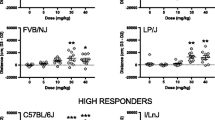Abstract
The acute administration of moderate to high doses (>2 mg/kg) of amphetamine (AMPH) to rats produces a multiphasic behavioral response consisting of an initial period of locomotor activity followed by episodes of intense stereotyped behavior, and a period of post-stereotypy locomotion. Repeated administration of the drug results in a sensitization with two components: more rapid onset of stereotypy and enhancement of the post-stereotypy locomotor activity. The studies presented below provide converging evidence that the two components of the sensitization are dissociable. 1. Rats from ten different strains or suppliers all exhibited more rapid onset of stereotypy following repeated AMPH pretreatment, whereas only five of these strains or supplier groups exhibited significantly enhanced post-stereotypy locomotion. 2. The time course differed for the development of these two components of the sensitization. 3. The recovery from sensitization differed for these two components of the behavioral response. Following withdrawal of the drug, post-stereotypy motor activity diminished within 2 months while the more rapid onset of stereotypy persisted for at least 3 months. These observations have particular relevance to future studies directed at specifying the biochemical substrates of the sensitization.
Similar content being viewed by others
References
Creese I, Iversen SD (1975) The pharmacological and anatomical substrates of the amphetamine response in the rat. Brain Res 83:419–436
Ellison G, Eisor MS, Huberman HS, Daniel F (1978) Long-term changes in dopaminergic innervation of caudate nucleus after continuous amphetamine administration. Science 201:276–278
Groves PM, Rebec GV (1976) Biochemistry and behavior: Some central actions of amphetamine and antipsychotic drugs. Ann Rev Psychol 27:91–127
Karczmar AG, Scudder CL (1967) Behavioral responses to drugs and brain catecholamine levels in mice of different strains and genera. Fed Proc 26:1186–1191
Kelly PH (1977) Drug-induced motor behavior. In: Iversen LL, Iversen SD, Snyder SH (eds) Handbook of psychopharmacology, vol 8. Plenum Press, New York, pp 295–331
Kelly PH, Seviour PW, Iversen SD (1975) Amphetamine and apomorphine responses in the rat following 6-OHDA lesions of the nucleus accumbens septi and corpus striatum. Brain Res 94:507–522
Kenny M, Leonard BE (1980) The effects of strain differences and emotional status of rats on the behavioral and neurochemical effects of chronic treatment with apomorphine. Prog Neuro-Psychopharmacol 4:161–170
Kokkinidis L, Anisman H (1980) Amphetamine models of paranoid schizophrenia: An overview and elaboration of animal experimentation. Psychol Bull 88:551–579
Kuczenski R, Leith NJ (1981) Chronic amphetamine: Is dopamine a link in or a mediator of the development of tolerance and reverse tolerance? Pharmacol Biochem Behav 15:405–413
Leith NJ, Kuczenski R (1981) Chronic amphetamine: Tolerance and reverse tolerance reflect different behavioral actions of the drug. Pharmacol Biochem Behav 15:399–404
Lynch M, Kenny M, Leonard BE (1977) The effect of chronic administration of d-amphetamine on regional changes in catecholamines in the rat brain. J Neurosci Res 3:295–300
Magos L (1969) Persistence of the effect of amphetamine on stereotyped activity in rats. Eur J Pharmacol 6:200–201
Rebec GV, Segal DS (1980) Apparent tolerance to some aspects of amphetamine stereotypy with long-term treatment. Pharmacol Biochem Behav 13:793–797
Reggiani A, Battaini F, Kobeyashi H, Spano P, Trabucchi M (1980) Genotype-dependent sensitivity to morphine: Role of different opiate receptor populations. Brain Res 189:289–294
Segal DS (1975) Behavioral and neurochemical correlates of repeated d-amphetamine administration. In: Mandell AJ (ed) Neurobiological mechanisms of adaptation and behavior. Raven Press, New York, pp 247–262
Segal DS, Mandell AJ (1974) Long-term administration of d-amphetamine: Progressive augmentation of motor activity and stereotypy. Pharmacol Biochem Behav 2:249–255
Short PH, Shuster L (1976) Changes in brain norepinephrine associated with sensitization to d-amphetamine. Psychopharmacology 48:59–67
Author information
Authors and Affiliations
Rights and permissions
About this article
Cite this article
Leith, N.J., Kuczenski, R. Two dissociable components of behavioral sensitization following repeated amphetamine administration. Psychopharmacology 76, 310–315 (1982). https://doi.org/10.1007/BF00449116
Received:
Issue Date:
DOI: https://doi.org/10.1007/BF00449116




